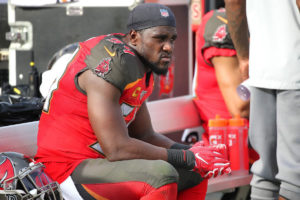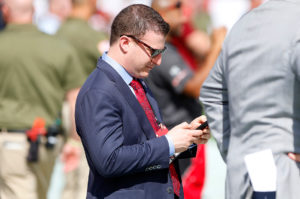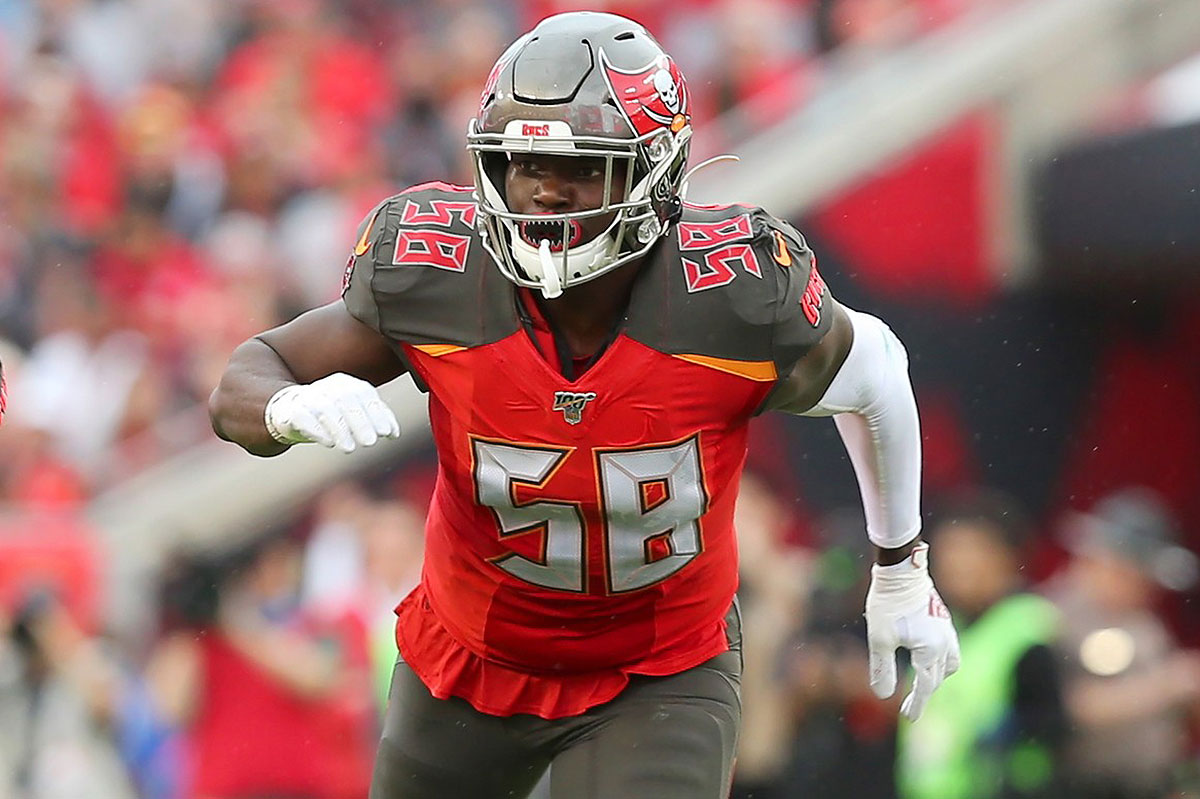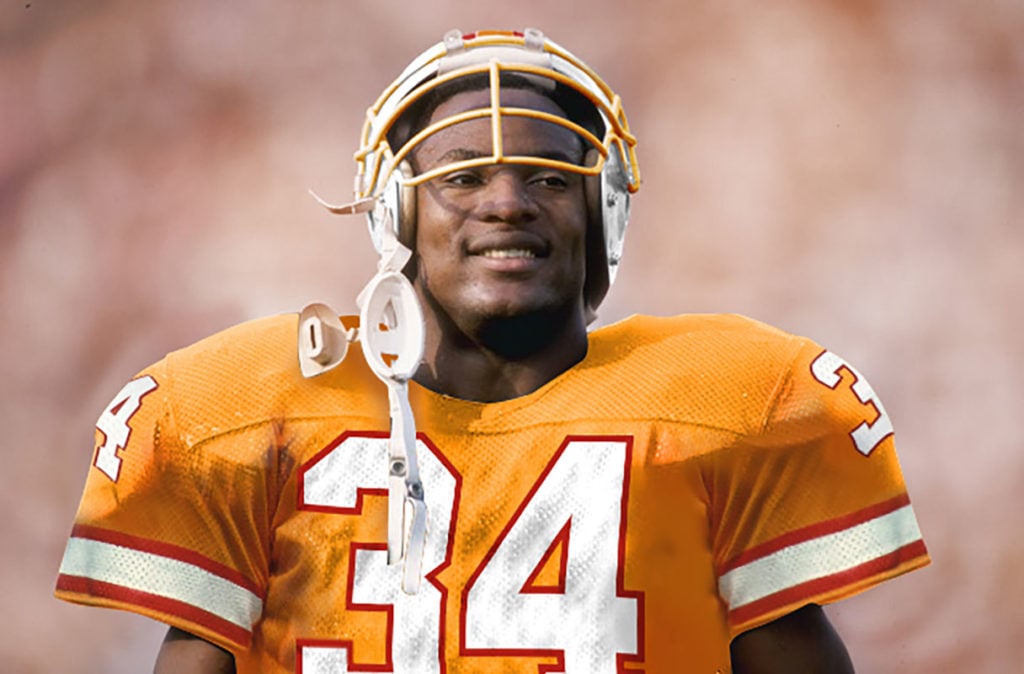FAB 2. Bucs’ Potential Salary Cap Nightmare In 2021
The NFL salary cap has gone up by an average of $10.8 million in each of the last five seasons. But all NFL teams, including Tampa Bay, are bracing for a dramatic decrease in the 2021 salary cap due to the potential revenue loss during the COVID-19-affected 2020 season, which will see declining team revenue, especially stadium revenue.
I outlined this in Fab 1 and detailed how it has affected the status of Tampa Bay’s best pass rusher, outside linebacker Shaquil Barrett, who was tagged as the team’s franchise player this offseason. But Barrett isn’t the only Buccaneer who could be affected by a dramatic decline in the NFL’s salary cap next season.

Bucs LB Lavonte David – Photo by: Cliff Welch/PR
A decrease in the 2021 salary cap could also affect the contract extensions for wide receiver Chris Godwin and inside linebacker Lavonte David, two players the Bucs would like to lock up with new deals for years to come. Godwin is in the final year of his rookie contract and is expected to earn $2,331,041 in 2020. David is in the final season of the six-year contract extension he signed in 2015, and is scheduled to earn $10.75 million in 2020.
The league’s salary cap in 2020 is $198.2 million, and NFL Network’s Ian Rapoport has reported that the salary cap could fall by as much as $40 million in 2021.
If that happens it would send the league back to a salary cap at the 2016 level.
NFL Salary Cap – Last 5 Years
2016: $155.27 million
2017: $167 million
2018: $177.2 million
2019: $188.2 million
2020: $198.2 million
What would that mean next year for the Bucs, who have just $4,873,799 million in cap room for the upcoming 2020 season? What would a salary cap around $158.2 million in 2021 look like?
It would be devastating to Tampa Bay.
The Bucs have just 45 players under contract for next season, and have already committed $151,882,587 to those players. That would leave $6,117,413 left to not only sign draft picks in 2021, but also add free agents.
And that $151,882,587 figure does not include some vitally important starters, who are pending free agents in 2021.
Barrett.
Godwin.
David.
Tight end Rob Gronkowski.
Defensive tackle Ndamukong Suh.
Not to mention some key reserves like offensive linemen Joe Haeg and Josh Wells, defensive lineman Rakeem Nunez-Roches, tight end Antony Auclair, linebacker Kevin Minter, cornerback and special teams ace Ryan Smith, backup quarterbacks Blaine Gabbert and Ryan Griffin and safeties Andrew Adams and Justin Evans.

Bucs director of football administration Mike Greenberg and GM Jason Licht – Photo by: Cliff Welch/PR
Under this nightmarish scenario, Bucs general manager Jason Licht and director of football administration Mike Greenberg would have to go to multiple players for restructuring to free up much-needed salary cap space in 2021. The only problem is that Tampa Bay only has six players under contract next year that are poised to make $10 million or more, so there isn’t much cap room to recoup.
Here is a list of the Top 10 highest paid Buccaneers in 2021:
QB Tom Brady – $25,000,000
WR Mike Evans – $13,450,000
LT Donovan Smith – $14,250,000
OLB Jason Pierre-Paul – $12,500,000
LG Ali Marpet – $10,650,000
C Ryan Jensen – $10,000,000
ILB Devin White – $8,170,223
TE Cameron Brate – $6,500,000
DE Will Gholston – $5,500,000
DT Vita Vea – $4,716,803
The contracts for Smith, Jensen, Brate and Gholston total $35,450,000 and the good news is that they could be released without any dead salary cap room for Tampa Bay. But in doing so, the Bucs would have to find a new starting left tackle, a starting center and a starting defensive lineman, in addition to trying to re-sign the likes of Barrett, Godwin, David and Gronkowski.
The COVID-19 pandemic doesn’t just affect the upcoming 2020 NFL season. It directly affects the 2021 campaign as well, especially from a looming salary cap standpoint.

Bucs director of football administration Mike Greenberg – Photo by: Cliff Welch/PR
There has been talk of the NFL and the NFL Players Association using a “flat cap” for next year, which would keep the salary cap at $198.2 million in 2021 and then spread out the projected decrease, which could be anywhere from $20 million, which is the conservative estimate, to $40 million, over the next four years instead of having the annual $10 million salary cap increases. Having a flat cap would put Tampa Bay $46,317,413 under the salary cap figure of $198.2 million in 2021, which would be $40.2 million more than it would have if the cap were to plummet to $158.2 million.
The Bucs aren’t the only team in this pickle. In fact, most NFL teams would suffer similar fates if the league doesn’t enact a flat cap in 2021, so there’s a pretty good chance it happens.
Scott Reynolds is in his 30th year of covering the Tampa Bay Buccaneers as the vice president, publisher and senior Bucs beat writer for PewterReport.com. Author of the popular SR's Fab 5 column on Fridays, Reynolds oversees web development and forges marketing partnerships for PewterReport.com in addition to his editorial duties. A graduate of Kansas State University in 1995, Reynolds spent six years giving back to the community as the defensive coordinator/defensive line coach for his sons' Pop Warner team, the South Pasco Predators. Reynolds can be reached at: [email protected]




